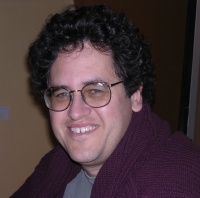John C. Baez
Appearance

John Carlos Baez (born 12 June 1961) is an American mathematical physicist and mathematician, a professor at University of California, Riverside, and a famous blogger.
Quotes
[edit]- The conformal invariance of the Yang-Mills equations in four dimensions greatly facilitates the study of the temporal asymptotic behavior of their solutions.
- (1989). "Scattering for the Yang-Mills equations". Trans. Amer. Math. Soc. 315: 823–832. DOI:10.1090/S0002-9947-1989-0949897-7. (p. 823)
- The real numbers are the dependable breadwinner of the family, the complete ordered field we all rely on. The complex numbers are a slightly flashier but still respectable younger brother: not ordered, but algebraically complete. The quaternions, being noncommutative, are the eccentric cousin who is shunned at important family gatherings. But the octonions are the crazy old uncle nobody lets out of the attic: they are nonassociative.
- (2002). "The octonions". Bull. Amer. Math. Soc. 39: 145–205. (p. 145)
- Besides their possible role in physics, the octonions are important because they tie together some algebraic structures that otherwise appear as isolated and inexplicable exceptions.
- (2002). "The octonions". Bull. Amer. Math. Soc. 39: 145–205. (p. 147)
- The most popular approach to quantum gravity is string theory. Despite decades of hard work by many very smart people, it's far from clear that this theory is successful. It's made no predictions that have been confirmed by experiment. In fact, it's made few predictions that we have any hope of testing anytime soon! Finding certain sorts of particles at the big new particle accelerator near Geneva would count as partial confirmation, but string theory says very little about the details of what we should expect. In fact, thanks to the vast "landscape" of string theory models that researchers are uncovering, it keeps getting harder to squeeze specific predictions out of this theory.
- (2008). "Should I be thinking about quantum gravity? (essay at the World Question Center)". edge.org.
- Quantum theory may be formulated using Hilbert spaces over any of the three associative normed division algebras: the real numbers, the complex numbers and the quaternions. Indeed, these three choices appear naturally in a number of axiomatic approaches. However, there are internal problems with real or quaternionic quantum theory. Here we argue that these problems can be resolved if we treat real, complex and quaternionic quantum theory as part of a unified structure. Dyson called this structure the "three-fold way". ... This three-fold classification sheds light on the physics of time reversal symmetry, and it already plays an important role in particle physics.
- (2011). "Division algebras and quantum theory". arXiv.org.

